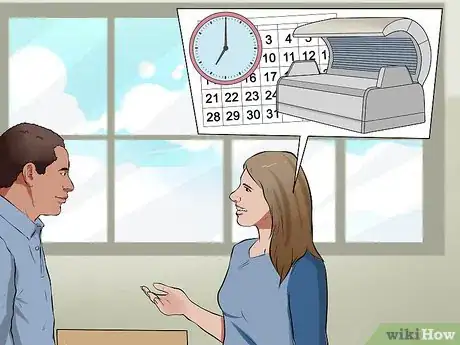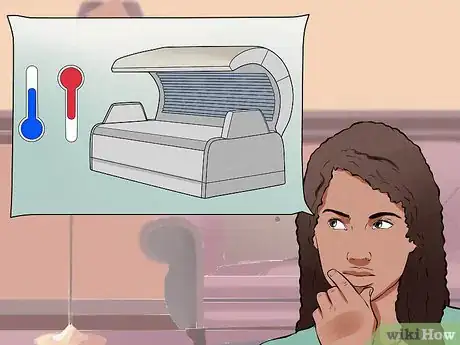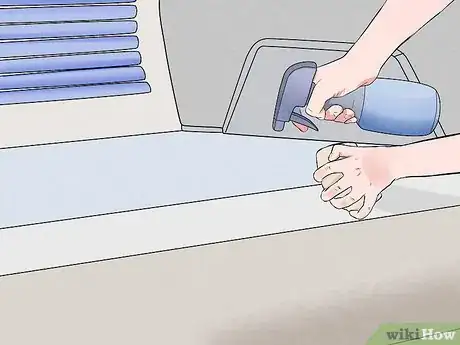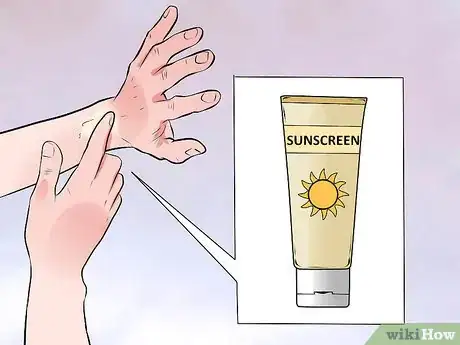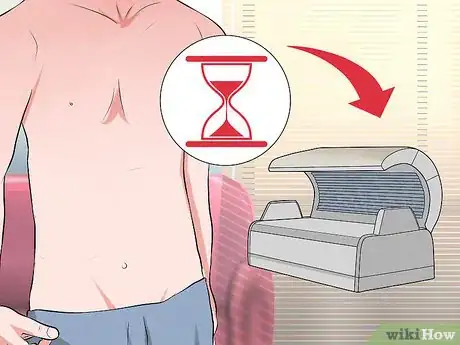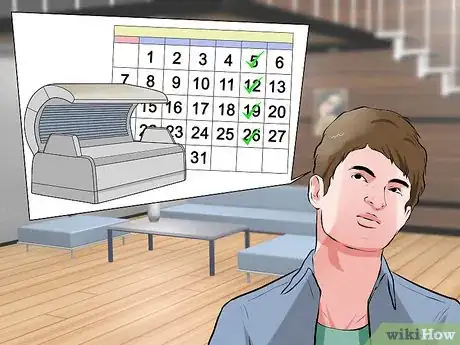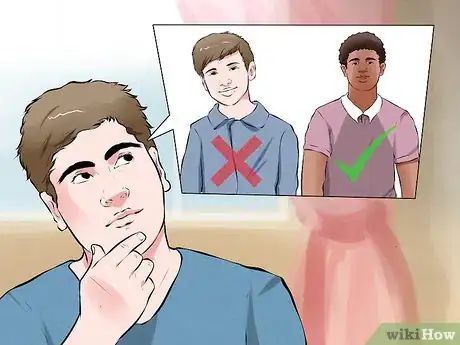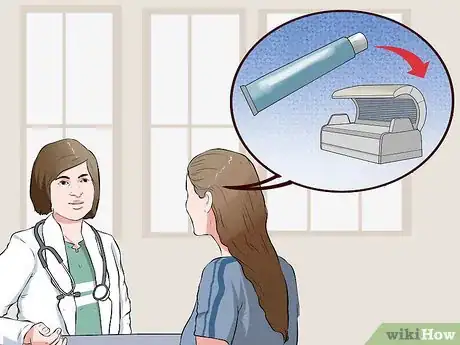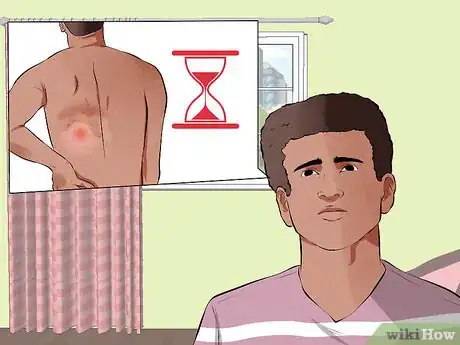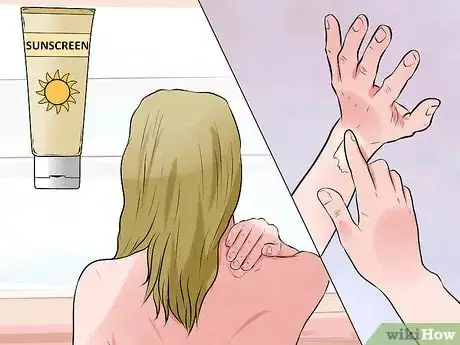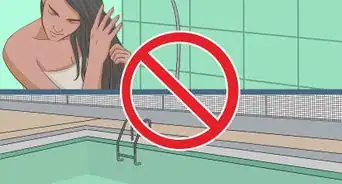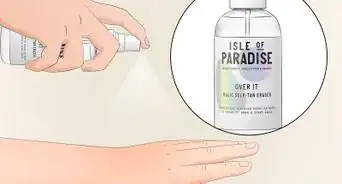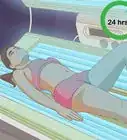This article was co-authored by wikiHow Staff. Our trained team of editors and researchers validate articles for accuracy and comprehensiveness. wikiHow's Content Management Team carefully monitors the work from our editorial staff to ensure that each article is backed by trusted research and meets our high quality standards.
There are 8 references cited in this article, which can be found at the bottom of the page.
This article has been viewed 32,971 times.
Learn more...
Sunbeds are often used in order to tan your body under more controlled settings than natural sunlight offers. However, sunbeds emit the same form of ultraviolet radiation as the sun, which has been linked to skin cancer. Taking such precautions as knowing your skin type, familiarizing yourself with the equipment, and taking other personal factors into account will help prevent you from using sunbeds in an unsafe manner.
Steps
Using a Sunbed
-
1Determine your skin type. Reduce the risk of sunburn by knowing how much tanning your skin can safely handle in a single session. Go online and take the Fitzpatrick Skin Typing Test. Based on the results, gain a clearer picture of the schedule that you will need to follow for your skin to achieve a base tan. Exact results may vary from person to person, but skin types generally fall into the following categories:
- Type 1: Extremely pale and/or white skin that burns quickly but resists tanning. The skin is usually freckled all over. Other features denoting people with Type 1 include red hair and blue or green eyes.
- Type 2: Skin that is more beige in color than Type 1, but still burns easily without tanning. People with Type 2 tend to be brunette or blond, moderately freckled, and blue- or green-eyed.
- Type 3: Skin is naturally light brown and may burn after too much sun exposure, but typically tans first. Type 3 people often have brown hair and eyes.
- Type 4: Skin is naturally light brown or olive in color. Type 4 skin tans with little difficulty, but may still burn over prolonged periods in the sun. People with Type 4 are usually brunettes with darker brown eyes than Type 3.
- Type 5: Skin is naturally browned and tans with little or no difficulty while seldom burning, if ever. People with Type 5 typically have extremely dark brown hair as well as eyes.
-
2Ask staff to help come up with a schedule. If needed, have an attendant help you determine your skin type. Then develop a regime to follow in order to acquire a base tan over multiple sessions. The exact regime may vary from one salon to another due to the power and UV output of their equipment, but expect a schedule similar to the following guidelines:[1] [2]
- Type 1: It is strongly recommended that people with Type 1 skin should never use sunbeds, due to their sensitivity to ultraviolet rays. However, if you persist, start off with sessions no longer than 1 minute. After three or more sessions, add another minute, but only if your skin still feels cool and comfortable after the first minute.
- Type 2: Limit yourself to 2 minutes for the first two sessions. Then add another minute for the next three, unless your skin begins to feel warm and/or uncomfortable after the first two minutes. If you still feel fine after three minutes of exposure, add another minute to your last session, for a total of six sessions.
- Type 3: Start with a 2-minute session. As long as your skin feels cool afterward, add another minute for your next two sessions. Bump it up to 4 minutes for your fourth and fifth session, unless your skin feels warmer than normal after the first 3 minutes. Finally, increase the time to 5 minutes for your last session, for a total of six sessions.
- Type 4: Begin with a 3-minute session. Follow that with a 4-minute session. Then increase your exposure to 5 minutes for your next two sessions. Add another minute for your last two sessions, for a total of six sessions. If your skin begins to feel uncomfortable at any point along the way, reduce the time to a safer amount of exposure.
- Type 5: Start with a 3-minute session. Then add another minute to your following session. Try 5 minutes for your third. If your skin still feels relatively cool after each session, add another minute to each following session until you reach 8 minutes for your final session.
Advertisement -
3Decide on which type of bed to use. Find out if the salon offers more than one style of sunbed. Ask the staff to help you decide which one is best for you, based on your skin type and desired effect. Also, ask them to clarify the length of time that you should limit each session to for each type of bed.[3]
- Low pressure beds aim to replicate the UV output of actual sunlight.
- High pressure beds alter the UV output to create a less temporary tan in a shorter amount of time.
-
4Clean the bed. Use the provided cleaning solution to spray and wipe down the bed before climbing in. The previous customer and/or staff may have already done so, but do it anyway to rest assured that the bed has been disinfected. If you do not find a cleaning solution on hand, ask the staff for some.
Protecting Your Body
-
1Protect your eyes. Shield them from UV rays with goggles that are specifically designed for sunbed-use. Rent or borrow one from the salon, depending on their policy. Invest in a pair of your own if you plan on making regular visits. Do not trust your eyelids, sunglasses, other forms of eye-wear to protect your eyes.[4]
- If you use a pair that belongs to the salon, make sure they have been cleaned since the last customer used them. A salon that does not use a cleaning solution to disinfect their eyewear may also prove to be unhygienic in other areas.[5]
- A lack of eye protection increases the risk of cataracts, conjunctivitis, and irritation.[6]
-
2Remove clothing as desired. Wear underwear or swimming gear to only tan those areas that will be visible to the public. Be mindful of where tan lines will appear. Wear briefs, speedos, or bikinis to show tanned flesh even when your shorts, skirt, or dress pulls up, thus exposing more leg. Or eliminate tan lines altogether and tan naked if permitted by the salon.[7]
- Before tanning naked, be advised that your nipples, genitals, and other delicate areas may burn before the rest of your body does.
-
3Apply sunscreen and tan accelerator. Minimize the harm of UV light by protecting yourself with sunscreen. Apply it wherever your skin is exposed. Wait a quarter of an hour before using the sunbed so your skin has time to absorb it.[8] Minimize your risk further by also using tan accelerator to acquire your desired tan in a shorter amount of time.[9]
- Sunscreen will help minimize the skin damage caused by UV light, but it won't eliminate it entirely.
- Use SPF-30 sunscreen or higher, even if you typically use a weaker formula outdoors. Remember that the sun is billions of miles from Earth, but the sunbed's lights are only a few inches from your skin.
- Although tanning accelerators contain ingredients that help defend your skin from the effects of ultraviolet light, they are not the same as SPF sunscreen. Do not use the two products interchangeably.
- Check your accelerator’s ingredients to make sure it includes L-tyrosine. Be aware that simple moisturizers are able to advertise themselves as tan accelerators, even without this active ingredient. This is only because moist skin technically does tan quicker than dry skin. However, a moisturizer will have minimal effect in a sunbed.
Caring for Your Skin Afterward
-
1Moisturize. Expect each sunbed session to continue to effect your skin well after the session ends. Apply moisturizer as needed over the next 12 hours or more to keep your skin from drying out, since moist skin tans more effectively than dry skin. Be doubly certain to do this if you shower, swim, sweat profusely, or are otherwise exposed to liquids after tanning, since these activities may wash off previous applications.[10]
-
2Give your skin a rest before your next session. Wait 24 hours at the bare minimum before tanning yourself again, whether indoors or outdoors. If you have Type 2 skin, wait at least 48 hours before your next session. To err on the side of caution, wait 72 hours, regardless of your skin type.[11] [12]
- Again, people with Type 1 skin should refrain from tanning in general. If you decide to do so anyway, always give your overly sensitive skin the maximum amount of rest in between sessions.
-
3Stick to a reasonable number of sessions per year. Limit yourself to a maximum of two or three per week if you only tan seasonally. If you plan on tanning all year long, stick to roughly once per week. Limit yourself to 60 sessions in total for the entire year to avoid overexposure.[13]
Understanding the Risks
-
1Be aware that UV rays are linked to skin cancer. Expect prolonged exposure to either natural or artificial light to increase the risk of melanoma. Be especially mindful of those areas of your body that do not normally receive much direct light. Refrain from tanning naked in sunbeds if your private parts rarely see the light of the day.[14]
- If you or any relative has suffered skin cancer in the past, consider this a warning sign that you are at much greater risk. Do not use sunbeds if your family has a history of melanoma.
-
2Consider your age. The younger you are, the greater the danger posed by UV rays. Sunbed use is often forbidden to anyone under the age of 18 accordingly. However, continue to regard yourself as a likely candidate for melanoma well after that. Use sunbeds sparingly or abstain from them entirely until you are 25 or older.[15]
-
3Take any medications into account. If you are currently taking any medication or topical creams, whether they are prescribed or over-the-counter, read the directions before tanning. Double-check for any warnings about extra sensitivity to sunlight. If the directions advise limiting your exposure to natural sunlight, take that to mean that you shouldn’t use a sunbed, either.[16]
- Consult your doctor about possible ramifications from medications that they prescribe for you, as well as any other health factors that may elevate your risk of skin cancer.
-
4Expect damage to take a long time to manifest. Be aware that the negative impacts of sunburn and overexposure may take as many as 20 years to show themselves. Refrain from tanning yourself and risking further damage if you have repeatedly suffered sunburns in the past. Be twice as reluctant to use sunbeds if you suffered those sunburns in your childhood, when you were most at risk of developing long-term damage.[17]
-
5Continue using sunscreen. Although some debate persists as to whether a base tan protects you against sunburn, err on the side of caution. Consider tanning as a natural reaction to previous overexposure in an attempt to prevent further damage. Use sunscreen and other forms of protection to avoid sunburn, rather than rely on your base tan to do the job for you.[18]
- Skin Types 1 and 2 should use a SPF-30 sunscreen or an even stronger SPF. So should anyone with a personal or family history of skin cancer or any other condition that makes them more sensitive to sunlight.[19]
- Skin Types 3, 4 and 5 should be safe to use a SPF-15 formula. However, using a stronger sunscreen is still advisable.[20]
- Give your skin a quarter of an hour to absorb the sunscreen before braving the sunshine. Check the directions for its lasting power. Never wait longer than two hours to apply more. Reapply more frequently when swimming or sweating profusely.
References
- ↑ http://www.carrotsun.co.uk/blogs/news/114355268-how-to-use-tanning-beds-sunbeds-a-complete-guide
- ↑ http://www.nhs.uk/chq/Pages/852.aspx?CategoryID=87
- ↑ http://www.icnirp.org/en/applications/sunbeds/index.html
- ↑ http://www.bbc.com/news/health-10987937
- ↑ http://www.carrotsun.co.uk/blogs/news/114355268-how-to-use-tanning-beds-sunbeds-a-complete-guide
- ↑ http://www.nhs.uk/chq/Pages/852.aspx?CategoryID=87
- ↑ http://www.carrotsun.co.uk/blogs/news/114355268-how-to-use-tanning-beds-sunbeds-a-complete-guide
- ↑ https://www.aad.org/public/spot-skin-cancer/learn-about-skin-cancer/prevent/how-to-apply-sunscreen
- ↑ http://www.carrotsun.co.uk/blogs/news/114355268-how-to-use-tanning-beds-sunbeds-a-complete-guide
- ↑ http://www.carrotsun.co.uk/blogs/news/114355268-how-to-use-tanning-beds-sunbeds-a-complete-guide
- ↑ http://www.sunbedassociation.org.uk/UV_Tanning/FAQs.aspx
- ↑ http://www.carrotsun.co.uk/blogs/news/114355268-how-to-use-tanning-beds-sunbeds-a-complete-guide
- ↑ http://www.sunbedassociation.org.uk/UV_Tanning/FAQs.aspx
- ↑ http://www.sunbedassociation.org.uk/UV_Tanning/FAQs.aspx
- ↑ http://www.nhs.uk/chq/Pages/852.aspx?CategoryID=87
- ↑ http://www.nhs.uk/chq/Pages/852.aspx?CategoryID=87
- ↑ http://www.nhs.uk/chq/Pages/852.aspx?CategoryID=87
- ↑ http://www.cancer.ie/reduce-your-risk/sunsmart/sunbeds/sunbed-myths#sthash.AfsCRFjx.Gngp14M3.dpbs
- ↑ http://www.webmd.com/beauty/sun/whats-best-sunscreen
- ↑ https://www.aad.org/public/spot-skin-cancer/learn-about-skin-cancer/prevent/how-to-apply-sunscreen
About This Article
Before you use a sunbed, you should work out what skin type you have, which will help you decide how long to tan. If you have light skin that burns easily, limit yourself to 2 minutes for your first 2 tanning sessions. If you have brown or olive skin that doesn’t burn so easily, start with 3 minutes a session. If your skin feels cool after your tanning sessions, try adding another minute for your third session. Whatever your skin type is, remember to protect your eyes with goggles. You can borrow these from the salon or invest in your own pair. Make sure you also apply sunscreen of SPF 30 or higher to help protect your skin from the UV rays. For more tips, including how to decide how much clothing to remove when tanning, read on!

